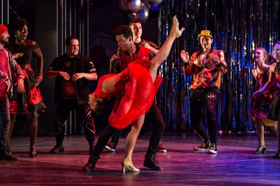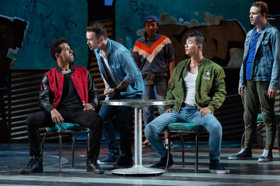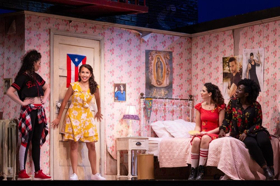Review: The WEST SIDE of the Glimmerglass Festival in Cooperstown, NY

Photo: Karli Cadel/The Glimmerglass Festival
Yes, it's still the Leonard Bernstein centennial (actually, his birthdate was August 25, 1918) and what better way to celebrate than at the Glimmerglass Festival with WEST SIDE STORY. It remains a unique creation, born out of the collaboration of four geniuses: Bernstein himself, of course, Jerome Robbins (choreographer-director), Arthur Laurents (book) and the "baby" of the group, then-newcomer Stephen Sondheim (lyricist/co-lyricist).
Directed here with a deft hand by Francesca Zambello, the Festival's Artistic & General Director, and the original choreography recreated by Julio Monge, entrusted by the Robbins Rights Trust to make the production move just right--no small element in this complex work--it soars. While the cast may lack the best dancers on Broadway (or at New York City Ballet, once Robbins' professional home) or the most seasoned performers on the scene, the spirit is in its bones.
What do we make out of this...well, what is it? It's often thought of as a "Broadway musical," but it's not like any musical seen before or after, even those involving any of the creators. Not surprising, the creators didn't give birth to the work easily, but they came up with something unique. Like a symphony or other classical piece, it can raise or lower the temperature on a dime. Like a ballet or modern dance piece, it flies. Like an opera, the arias, duets, quartets and other ensembles sing the action and form the characters--and ultimately break our hearts.

Brian Vu (Riff), PJ Palmer (Action). Photo:
Karli Cadel/The Glimmerglass Festival
The original was quite shocking in its time, dealing with ugly reality in a musical with the racial and social prejudices of gangs, cops, parents and almost everyone on the scene--but compared to today's violence, it's Peter Pan. (And compared to the prejudices festered by the current political regime in this country, it's almost Shangri-La.) Yes, there are parallels to Shakespeare's ROMEO AND JULIET, its inspiration, but that's easy to forget. The show's the thing.
Though it's hard to imagine WEST SIDE STORY without Robbins's dances (Note: It's being done on Broadway in the 2019 season with totally new choreography for the first time), without Bernstein's music it simply could not exist. It's true from the first notes of the score all the way to the end: in the ethereal "Something's Coming," the poignancy of "One Hand, One Heart," the urgency and rhythms of "The Dance at the Gym" or "America," or the laughs of "Gee, Officer Krupke," or "I Feel Pretty," Bernstein pulled the strings. He fought to make it more operatic, though he was often thwarted, but he brought out Sondheim to improve on the words, Laurents to draw the people, Robbins to make it move like no one else could. At Glimmerglass, conductor David Charles Abell helped us hear the masterwork Bernstein created.

Kresley Figueroa (Francisca), Tesia Kwarteng (Rosalia).
Photo: Karli Cadel/The Glimmerglass Festival
Zambello and Monge brought out some fine performances. At the top of the list: Brian Vu's Riff, Vanessa Becerra's Maria, Corey Bourbonniere's Bernardo, Tesia Kwarteng's Rosalia and, especially, Amanda Castro's Anita all hit the mark for me. Peter J. Davison's expressionistic scenic design (with Mark McCullough's lighting) uses fire escapes, water towers, chain link fences and hotel signs to ground the gritty action, going more realistic when he opens Maria's room in a smart touch. Jessica Jahn's lively costumes add personality to the women without letting the men become too Broadway-ish.
The Glimmerglass Festival's WEST SIDE STORY is a co-production of the Houston Grand Opera, the Lyric Opera of Chicago and, most recently announced, Atlanta Opera (headed by SILENT NIGHT's Tomer Zvulun). The entire run, through August 24, is sold out, but check for cancellations. You'll be sorry to miss it.
Reader Reviews

Videos

